2015 FORD SUPER DUTY fuel cap
[x] Cancel search: fuel capPage 4 of 84
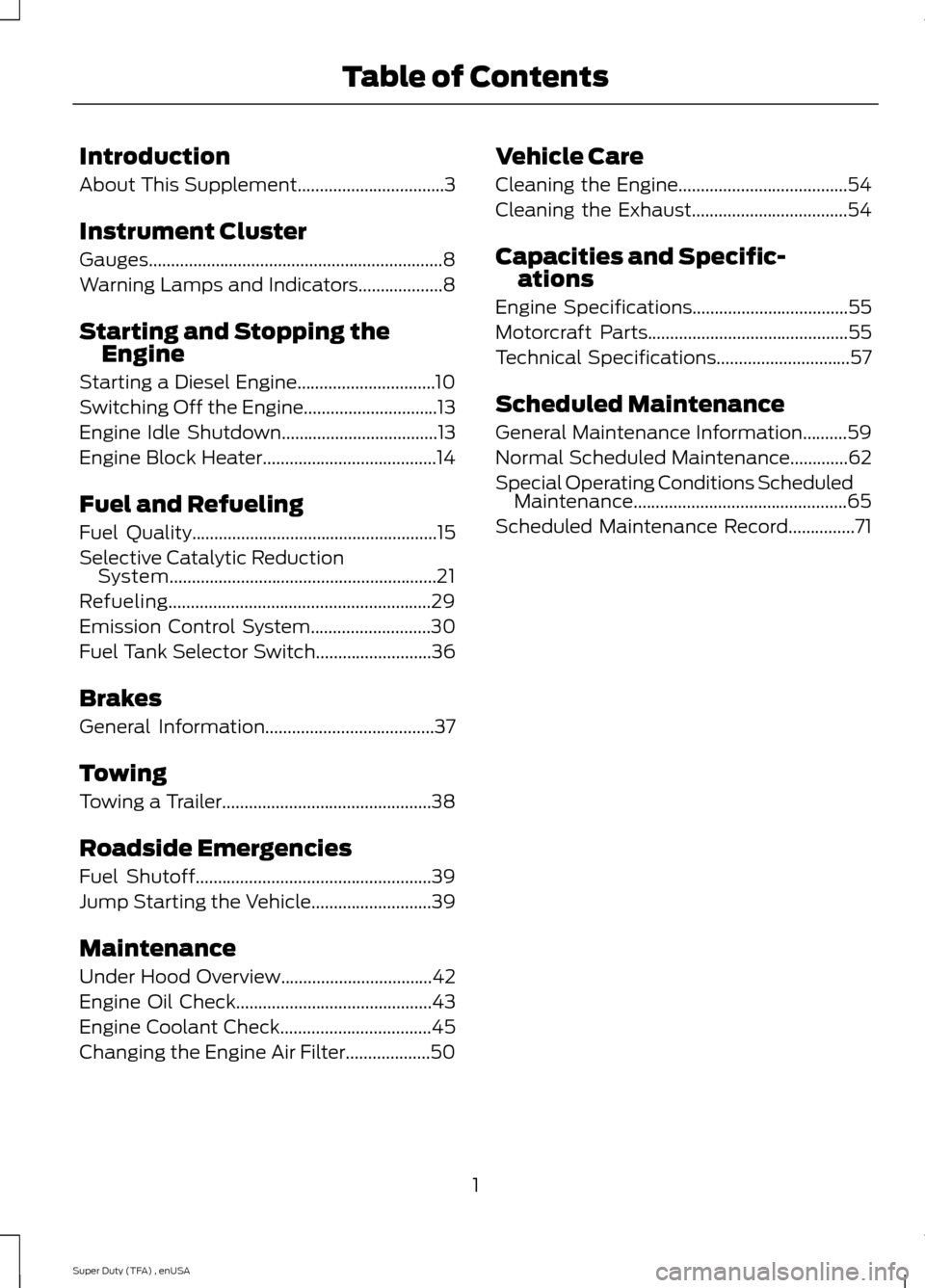
Introduction
About This Supplement.................................3
Instrument Cluster
Gauges..................................................................8
Warning Lamps and Indicators...................8
Starting and Stopping the Engine
Starting a Diesel Engine...............................10
Switching Off the Engine..............................13
Engine Idle Shutdown
...................................13
Engine Block Heater.......................................14
Fuel and Refueling
Fuel Quality
.......................................................15
Selective Catalytic Reduction System............................................................21
Refueling...........................................................29
Emission Control System
...........................30
Fuel Tank Selector Switch..........................36
Brakes
General Information......................................37
Towing
Towing a Trailer...............................................38
Roadside Emergencies
Fuel Shutoff.....................................................39
Jump Starting the Vehicle...........................39
Maintenance
Under Hood Overview..................................42
Engine Oil Check............................................43
Engine Coolant Check
..................................45
Changing the Engine Air Filter...................50 Vehicle Care
Cleaning the Engine......................................54
Cleaning the Exhaust...................................54
Capacities and Specific-
ations
Engine Specifications
...................................55
Motorcraft Parts
.............................................55
Technical Specifications
..............................57
Scheduled Maintenance
General Maintenance Information
..........59
Normal Scheduled Maintenance.............62
Special Operating Conditions Scheduled Maintenance................................................65
Scheduled Maintenance Record
...............71
1
Super Duty (TFA) , enUSA Table of Contents
Page 16 of 84
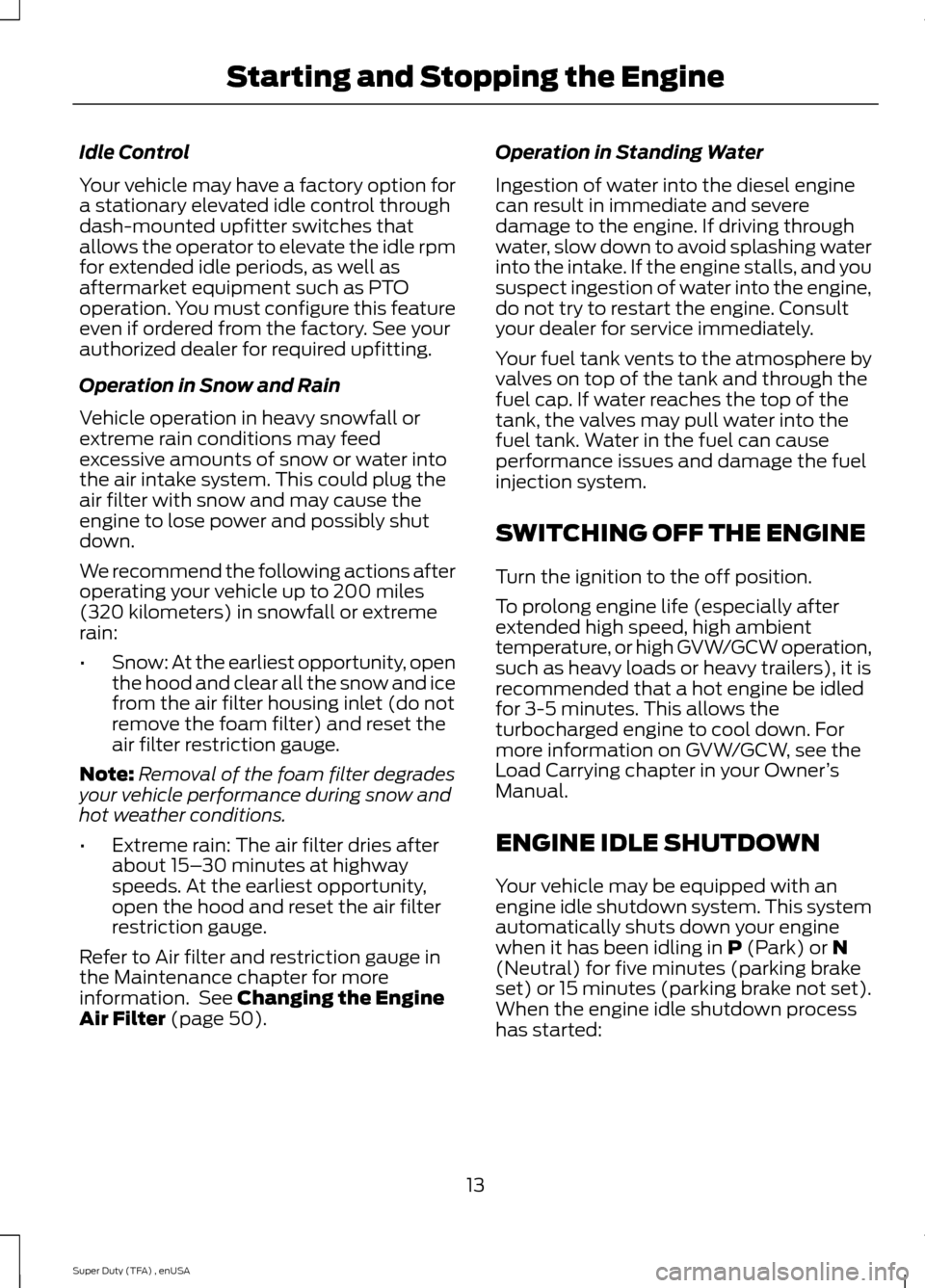
Idle Control
Your vehicle may have a factory option for
a stationary elevated idle control through
dash-mounted upfitter switches that
allows the operator to elevate the idle rpm
for extended idle periods, as well as
aftermarket equipment such as PTO
operation. You must configure this feature
even if ordered from the factory. See your
authorized dealer for required upfitting.
Operation in Snow and Rain
Vehicle operation in heavy snowfall or
extreme rain conditions may feed
excessive amounts of snow or water into
the air intake system. This could plug the
air filter with snow and may cause the
engine to lose power and possibly shut
down.
We recommend the following actions after
operating your vehicle up to 200 miles
(320 kilometers) in snowfall or extreme
rain:
•
Snow: At the earliest opportunity, open
the hood and clear all the snow and ice
from the air filter housing inlet (do not
remove the foam filter) and reset the
air filter restriction gauge.
Note: Removal of the foam filter degrades
your vehicle performance during snow and
hot weather conditions.
• Extreme rain: The air filter dries after
about 15– 30 minutes at highway
speeds. At the earliest opportunity,
open the hood and reset the air filter
restriction gauge.
Refer to Air filter and restriction gauge in
the Maintenance chapter for more
information. See Changing the Engine
Air Filter (page 50). Operation in Standing Water
Ingestion of water into the diesel engine
can result in immediate and severe
damage to the engine. If driving through
water, slow down to avoid splashing water
into the intake. If the engine stalls, and you
suspect ingestion of water into the engine,
do not try to restart the engine. Consult
your dealer for service immediately.
Your fuel tank vents to the atmosphere by
valves on top of the tank and through the
fuel cap. If water reaches the top of the
tank, the valves may pull water into the
fuel tank. Water in the fuel can cause
performance issues and damage the fuel
injection system.
SWITCHING OFF THE ENGINE
Turn the ignition to the off position.
To prolong engine life (especially after
extended high speed, high ambient
temperature, or high GVW/GCW operation,
such as heavy loads or heavy trailers), it is
recommended that a hot engine be idled
for 3-5 minutes. This allows the
turbocharged engine to cool down. For
more information on GVW/GCW, see the
Load Carrying chapter in your Owner
’s
Manual.
ENGINE IDLE SHUTDOWN
Your vehicle may be equipped with an
engine idle shutdown system. This system
automatically shuts down your engine
when it has been idling in
P (Park) or N
(Neutral) for five minutes (parking brake
set) or 15 minutes (parking brake not set).
When the engine idle shutdown process
has started:
13
Super Duty (TFA) , enUSA Starting and Stopping the Engine
Page 22 of 84
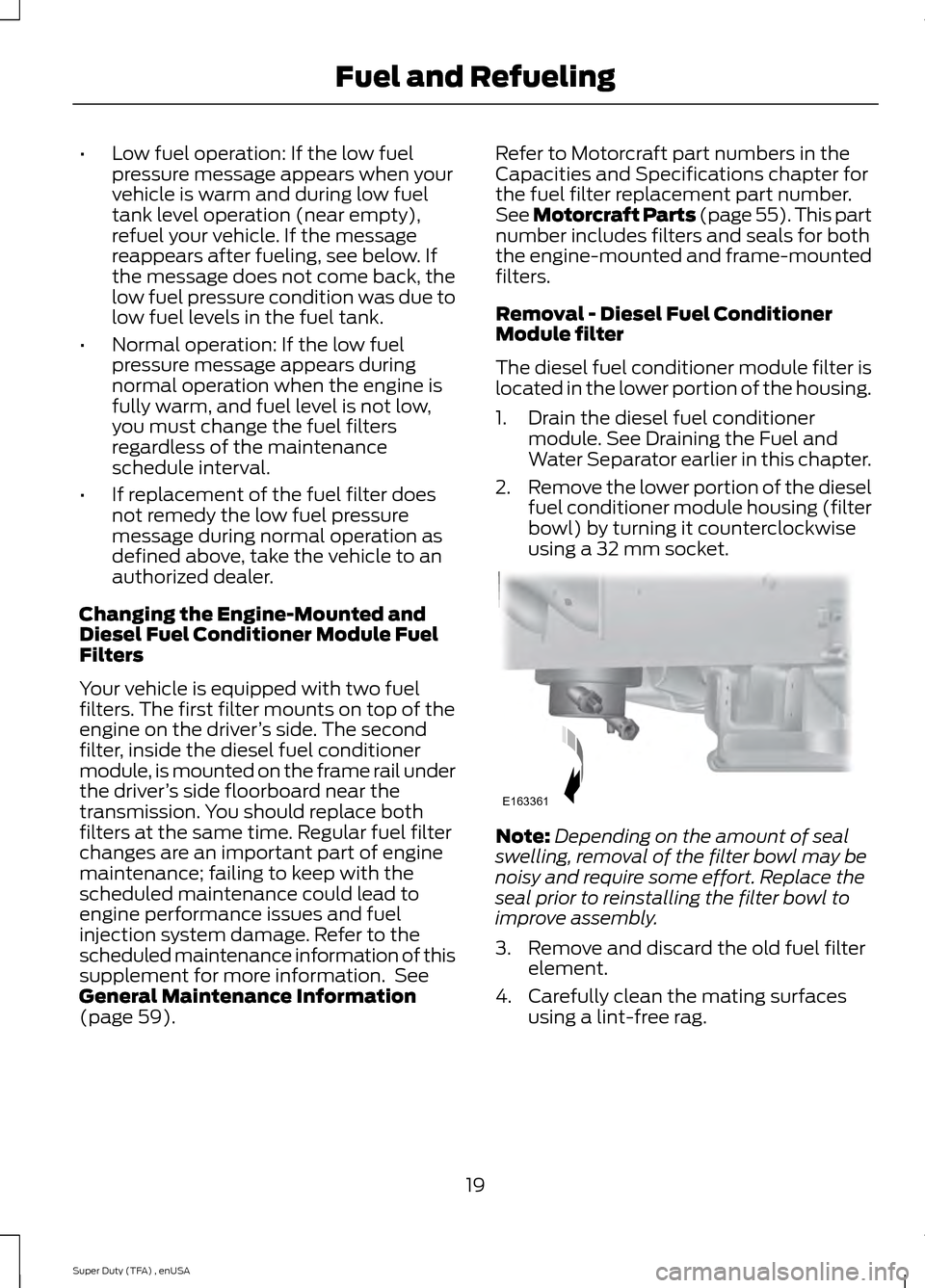
•
Low fuel operation: If the low fuel
pressure message appears when your
vehicle is warm and during low fuel
tank level operation (near empty),
refuel your vehicle. If the message
reappears after fueling, see below. If
the message does not come back, the
low fuel pressure condition was due to
low fuel levels in the fuel tank.
• Normal operation: If the low fuel
pressure message appears during
normal operation when the engine is
fully warm, and fuel level is not low,
you must change the fuel filters
regardless of the maintenance
schedule interval.
• If replacement of the fuel filter does
not remedy the low fuel pressure
message during normal operation as
defined above, take the vehicle to an
authorized dealer.
Changing the Engine-Mounted and
Diesel Fuel Conditioner Module Fuel
Filters
Your vehicle is equipped with two fuel
filters. The first filter mounts on top of the
engine on the driver ’s side. The second
filter, inside the diesel fuel conditioner
module, is mounted on the frame rail under
the driver ’s side floorboard near the
transmission. You should replace both
filters at the same time. Regular fuel filter
changes are an important part of engine
maintenance; failing to keep with the
scheduled maintenance could lead to
engine performance issues and fuel
injection system damage. Refer to the
scheduled maintenance information of this
supplement for more information. See
General Maintenance Information
(page 59). Refer to Motorcraft part numbers in the
Capacities and Specifications chapter for
the fuel filter replacement part number.
See Motorcraft Parts (page 55). This part
number includes filters and seals for both
the engine-mounted and frame-mounted
filters.
Removal - Diesel Fuel Conditioner
Module filter
The diesel fuel conditioner module filter is
located in the lower portion of the housing.
1. Drain the diesel fuel conditioner
module. See Draining the Fuel and
Water Separator earlier in this chapter.
2. Remove the lower portion of the diesel
fuel conditioner module housing (filter
bowl) by turning it counterclockwise
using a 32 mm socket. Note:
Depending on the amount of seal
swelling, removal of the filter bowl may be
noisy and require some effort. Replace the
seal prior to reinstalling the filter bowl to
improve assembly.
3. Remove and discard the old fuel filter element.
4. Carefully clean the mating surfaces using a lint-free rag.
19
Super Duty (TFA) , enUSA Fuel and RefuelingE163361
Page 23 of 84
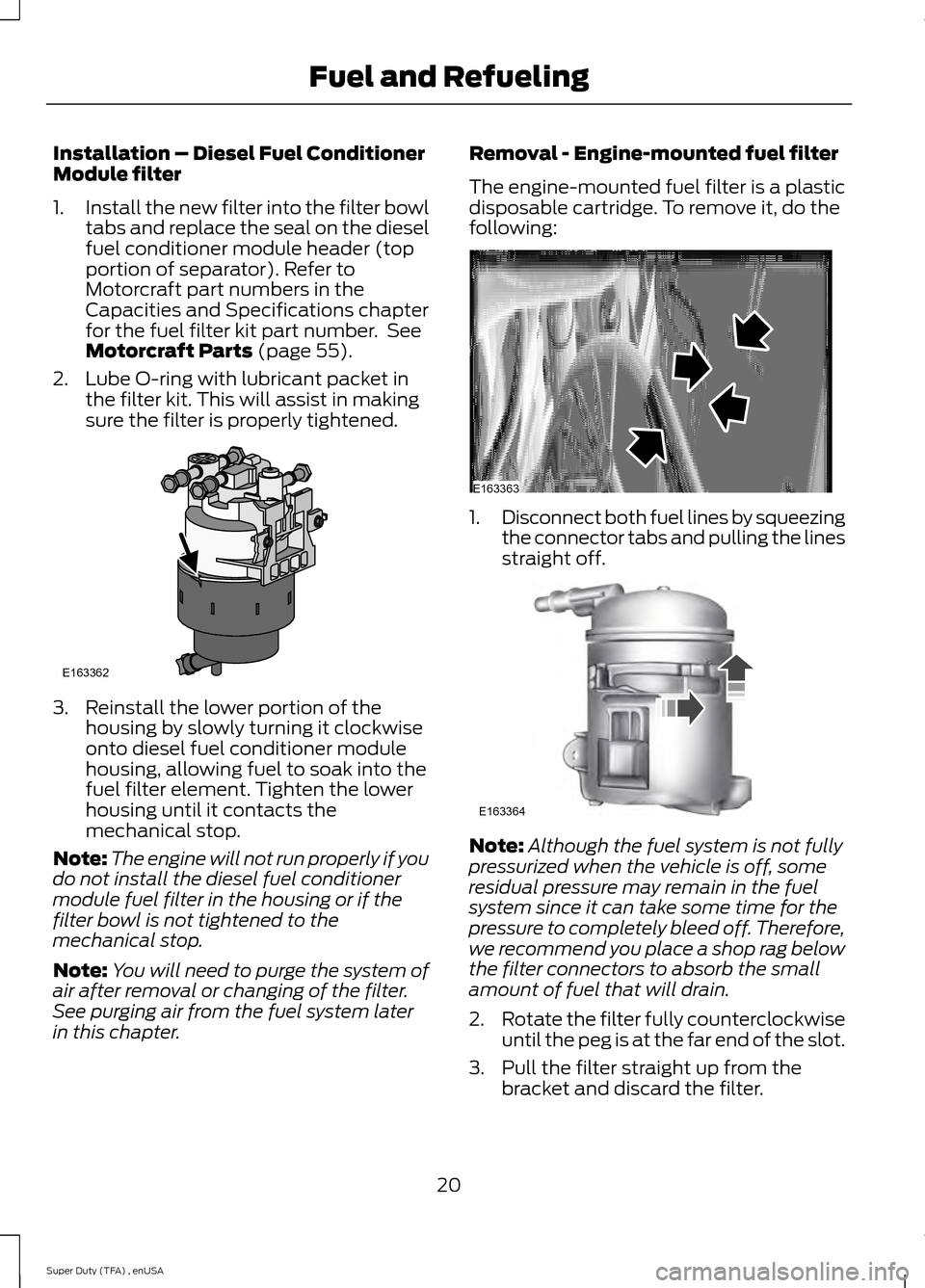
Installation – Diesel Fuel Conditioner
Module filter
1.
Install the new filter into the filter bowl
tabs and replace the seal on the diesel
fuel conditioner module header (top
portion of separator). Refer to
Motorcraft part numbers in the
Capacities and Specifications chapter
for the fuel filter kit part number. See
Motorcraft Parts (page 55).
2. Lube O-ring with lubricant packet in the filter kit. This will assist in making
sure the filter is properly tightened. 3. Reinstall the lower portion of the
housing by slowly turning it clockwise
onto diesel fuel conditioner module
housing, allowing fuel to soak into the
fuel filter element. Tighten the lower
housing until it contacts the
mechanical stop.
Note: The engine will not run properly if you
do not install the diesel fuel conditioner
module fuel filter in the housing or if the
filter bowl is not tightened to the
mechanical stop.
Note: You will need to purge the system of
air after removal or changing of the filter.
See purging air from the fuel system later
in this chapter. Removal - Engine-mounted fuel filter
The engine-mounted fuel filter is a plastic
disposable cartridge. To remove it, do the
following:
1.
Disconnect both fuel lines by squeezing
the connector tabs and pulling the lines
straight off. Note:
Although the fuel system is not fully
pressurized when the vehicle is off, some
residual pressure may remain in the fuel
system since it can take some time for the
pressure to completely bleed off. Therefore,
we recommend you place a shop rag below
the filter connectors to absorb the small
amount of fuel that will drain.
2. Rotate the filter fully counterclockwise
until the peg is at the far end of the slot.
3. Pull the filter straight up from the bracket and discard the filter.
20
Super Duty (TFA) , enUSA Fuel and RefuelingE163362 E163363 E163364
Page 27 of 84
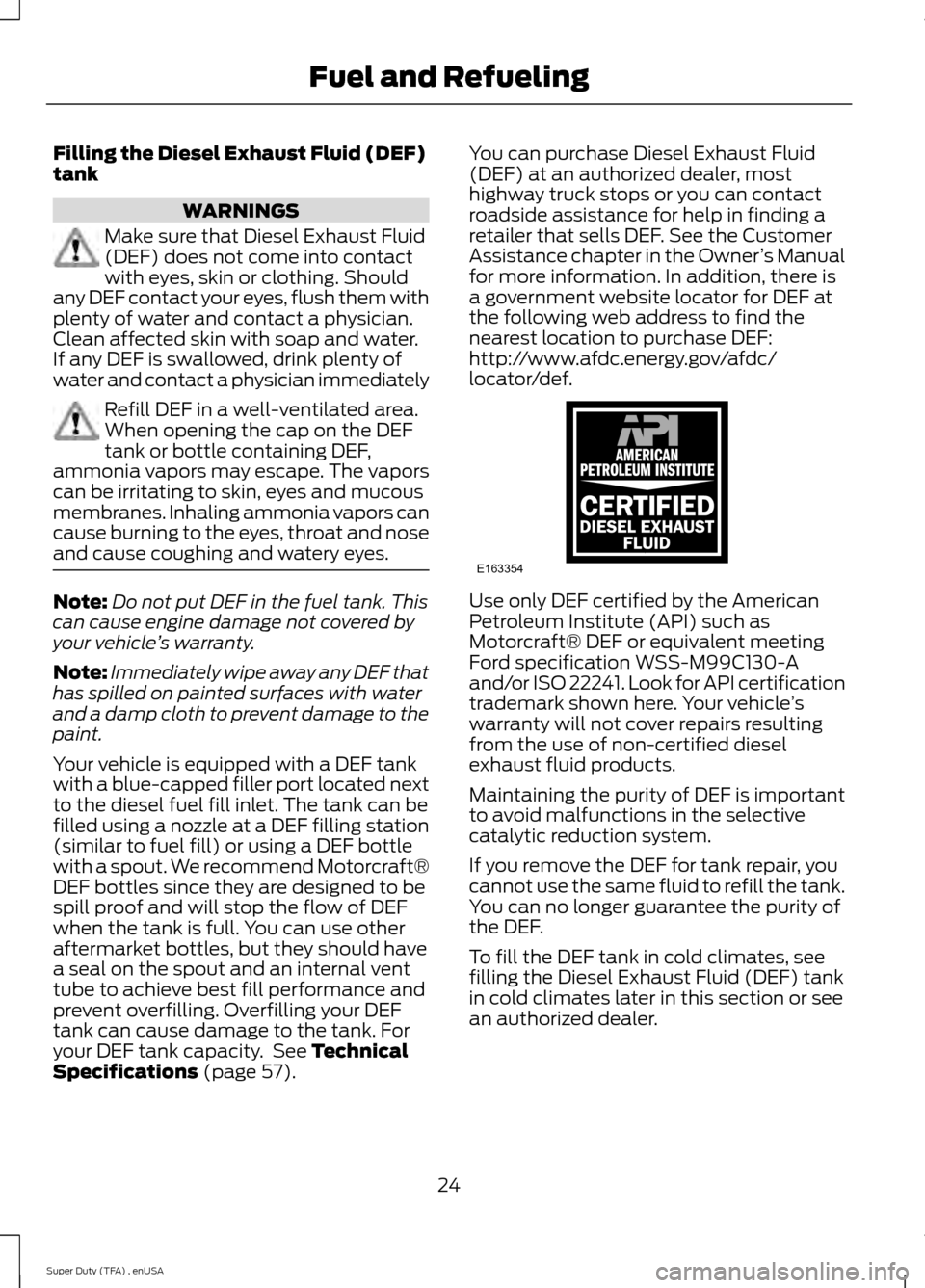
Filling the Diesel Exhaust Fluid (DEF)
tank
WARNINGS
Make sure that Diesel Exhaust Fluid
(DEF) does not come into contact
with eyes, skin or clothing. Should
any DEF contact your eyes, flush them with
plenty of water and contact a physician.
Clean affected skin with soap and water.
If any DEF is swallowed, drink plenty of
water and contact a physician immediately Refill DEF in a well-ventilated area.
When opening the cap on the DEF
tank or bottle containing DEF,
ammonia vapors may escape. The vapors
can be irritating to skin, eyes and mucous
membranes. Inhaling ammonia vapors can
cause burning to the eyes, throat and nose
and cause coughing and watery eyes. Note:
Do not put DEF in the fuel tank. This
can cause engine damage not covered by
your vehicle ’s warranty.
Note: Immediately wipe away any DEF that
has spilled on painted surfaces with water
and a damp cloth to prevent damage to the
paint.
Your vehicle is equipped with a DEF tank
with a blue-capped filler port located next
to the diesel fuel fill inlet. The tank can be
filled using a nozzle at a DEF filling station
(similar to fuel fill) or using a DEF bottle
with a spout. We recommend Motorcraft®
DEF bottles since they are designed to be
spill proof and will stop the flow of DEF
when the tank is full. You can use other
aftermarket bottles, but they should have
a seal on the spout and an internal vent
tube to achieve best fill performance and
prevent overfilling. Overfilling your DEF
tank can cause damage to the tank. For
your DEF tank capacity. See Technical
Specifications (page 57). You can purchase Diesel Exhaust Fluid
(DEF) at an authorized dealer, most
highway truck stops or you can contact
roadside assistance for help in finding a
retailer that sells DEF. See the Customer
Assistance chapter in the Owner
’s Manual
for more information. In addition, there is
a government website locator for DEF at
the following web address to find the
nearest location to purchase DEF:
http://www.afdc.energy.gov/afdc/
locator/def. Use only DEF certified by the American
Petroleum Institute (API) such as
Motorcraft® DEF or equivalent meeting
Ford specification WSS-M99C130-A
and/or ISO 22241. Look for API certification
trademark shown here. Your vehicle
’s
warranty will not cover repairs resulting
from the use of non-certified diesel
exhaust fluid products.
Maintaining the purity of DEF is important
to avoid malfunctions in the selective
catalytic reduction system.
If you remove the DEF for tank repair, you
cannot use the same fluid to refill the tank.
You can no longer guarantee the purity of
the DEF.
To fill the DEF tank in cold climates, see
filling the Diesel Exhaust Fluid (DEF) tank
in cold climates later in this section or see
an authorized dealer.
24
Super Duty (TFA) , enUSA Fuel and RefuelingE163354)E163354
Page 28 of 84

Diesel Exhaust Fluid (DEF) bottle fill with
spout
The following procedure applies to
Motorcraft® Diesel Exhaust Fluid (DEF) or
similar diesel exhaust fluid bottles; for
other brands or bottle types, refer to the
instructions on the bottle label.
1. Remove the cap from the DEF
container. Remove the spout from the
bottle and insert the straw end into the
bottle. Ensure you align the arrow
above the nut with the bottle handle
and the small tube end extends into
the far corner of the bottle. Twist the
spout nut on the container until it is
tight. 2.
Open the DEF filler port on your vehicle
by turning the blue cap
counterclockwise. Do not put DEF in
the fuel tank. This can cause engine
damage not covered by your vehicle ’s
warranty. 3. Lift and hold the DEF container,
without tipping, and insert the spout
into the DEF filler port until the small
black seal on the spout completely
seats into the filler port. 4.
While filling, the fluid level in the bottle
will continually drop. 25
Super Duty (TFA) , enUSA Fuel and RefuelingE163355 E163356 E163357 E163358
Page 29 of 84
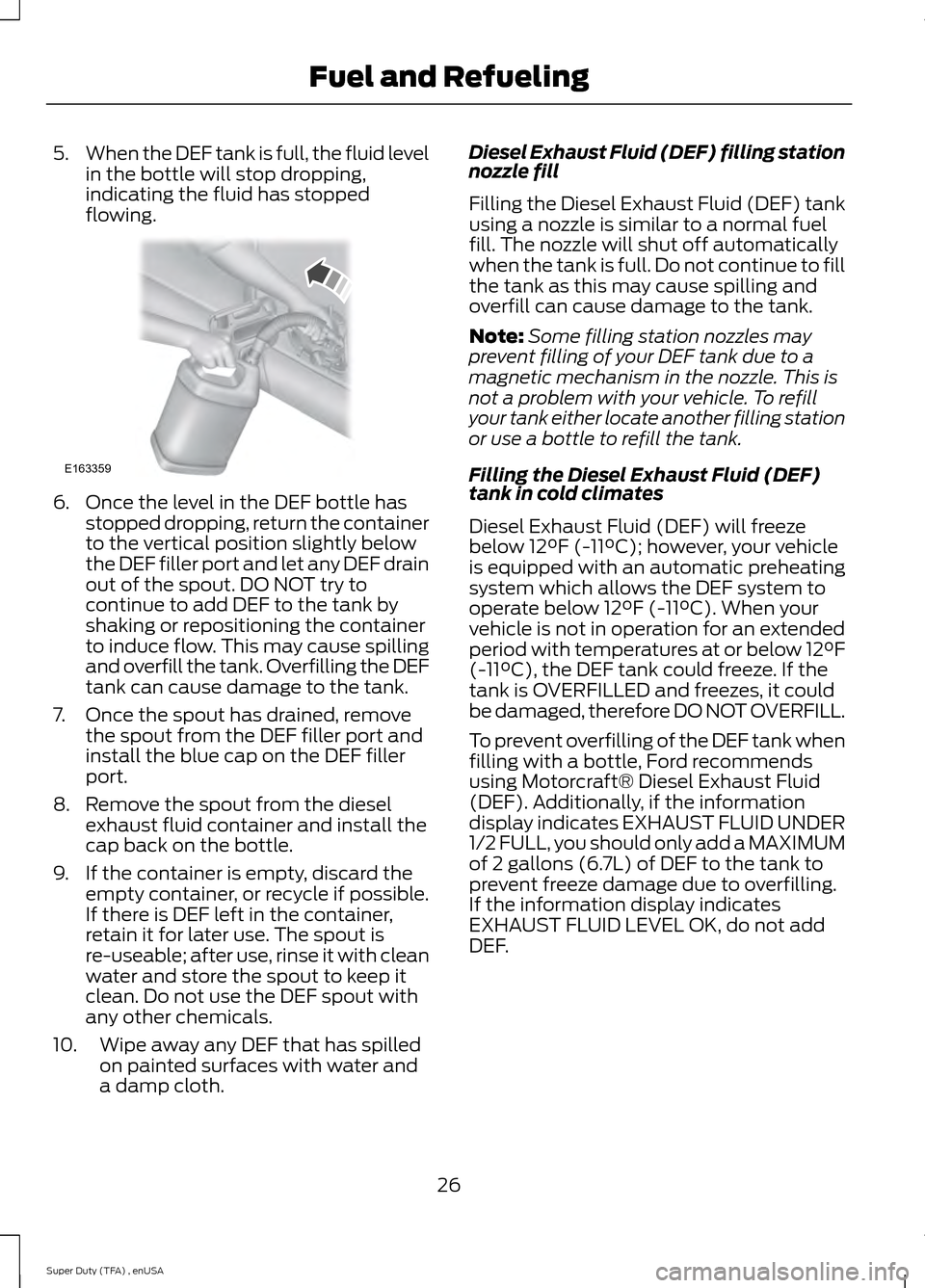
5.
When the DEF tank is full, the fluid level
in the bottle will stop dropping,
indicating the fluid has stopped
flowing. 6. Once the level in the DEF bottle has
stopped dropping, return the container
to the vertical position slightly below
the DEF filler port and let any DEF drain
out of the spout. DO NOT try to
continue to add DEF to the tank by
shaking or repositioning the container
to induce flow. This may cause spilling
and overfill the tank. Overfilling the DEF
tank can cause damage to the tank.
7. Once the spout has drained, remove the spout from the DEF filler port and
install the blue cap on the DEF filler
port.
8. Remove the spout from the diesel exhaust fluid container and install the
cap back on the bottle.
9. If the container is empty, discard the empty container, or recycle if possible.
If there is DEF left in the container,
retain it for later use. The spout is
re-useable; after use, rinse it with clean
water and store the spout to keep it
clean. Do not use the DEF spout with
any other chemicals.
10. Wipe away any DEF that has spilled on painted surfaces with water and
a damp cloth. Diesel Exhaust Fluid (DEF) filling station
nozzle fill
Filling the Diesel Exhaust Fluid (DEF) tank
using a nozzle is similar to a normal fuel
fill. The nozzle will shut off automatically
when the tank is full. Do not continue to fill
the tank as this may cause spilling and
overfill can cause damage to the tank.
Note:
Some filling station nozzles may
prevent filling of your DEF tank due to a
magnetic mechanism in the nozzle. This is
not a problem with your vehicle. To refill
your tank either locate another filling station
or use a bottle to refill the tank.
Filling the Diesel Exhaust Fluid (DEF)
tank in cold climates
Diesel Exhaust Fluid (DEF) will freeze
below 12°F (-11°C); however, your vehicle
is equipped with an automatic preheating
system which allows the DEF system to
operate below 12°F (-11°C). When your
vehicle is not in operation for an extended
period with temperatures at or below 12°F
(-11°C), the DEF tank could freeze. If the
tank is OVERFILLED and freezes, it could
be damaged, therefore DO NOT OVERFILL.
To prevent overfilling of the DEF tank when
filling with a bottle, Ford recommends
using Motorcraft® Diesel Exhaust Fluid
(DEF). Additionally, if the information
display indicates EXHAUST FLUID UNDER
1/2 FULL, you should only add a MAXIMUM
of 2 gallons (6.7L) of DEF to the tank to
prevent freeze damage due to overfilling.
If the information display indicates
EXHAUST FLUID LEVEL OK, do not add
DEF.
26
Super Duty (TFA) , enUSA Fuel and RefuelingE163359
Page 30 of 84
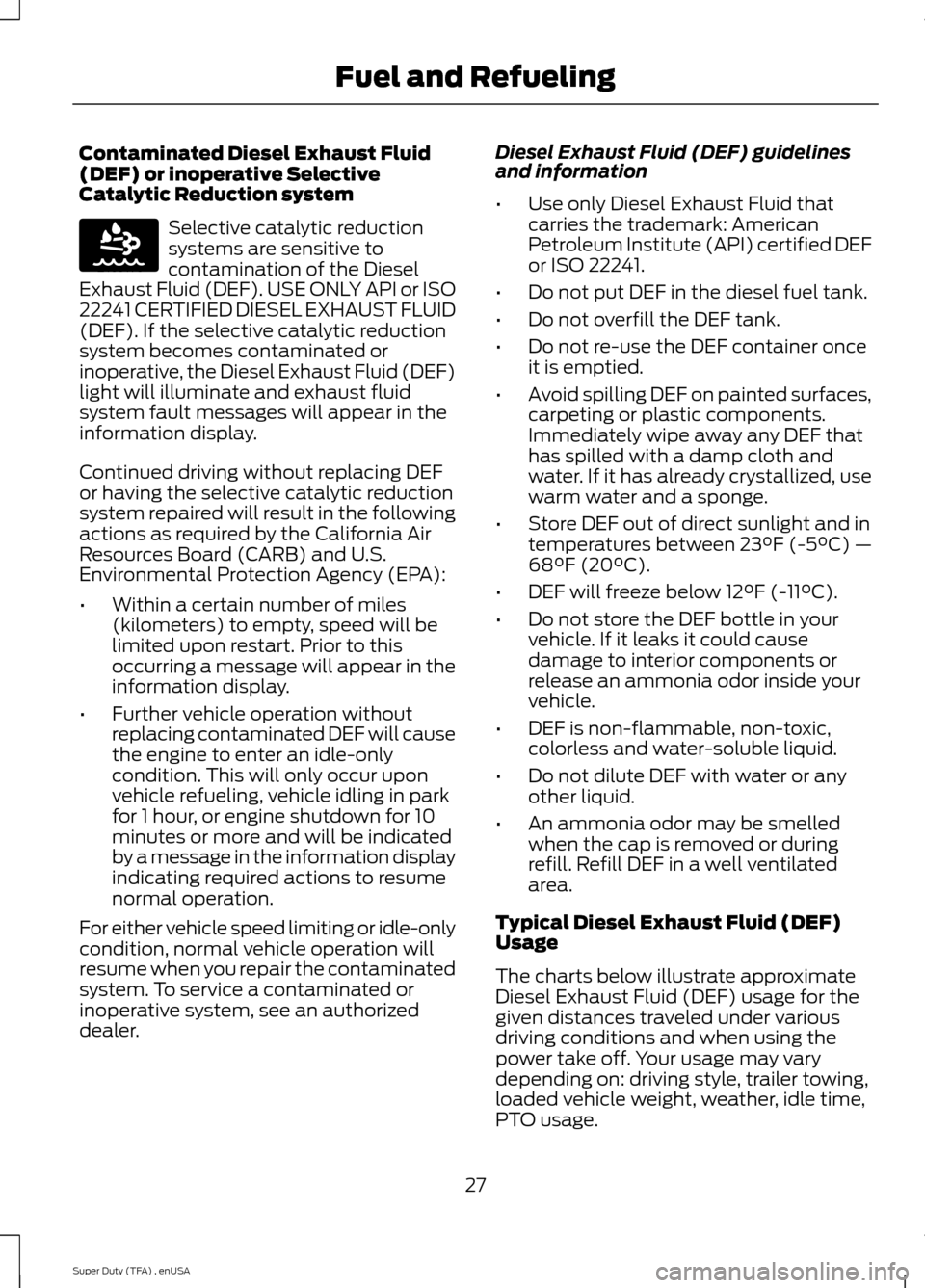
Contaminated Diesel Exhaust Fluid
(DEF) or inoperative Selective
Catalytic Reduction system
Selective catalytic reduction
systems are sensitive to
contamination of the Diesel
Exhaust Fluid (DEF). USE ONLY API or ISO
22241 CERTIFIED DIESEL EXHAUST FLUID
(DEF). If the selective catalytic reduction
system becomes contaminated or
inoperative, the Diesel Exhaust Fluid (DEF)
light will illuminate and exhaust fluid
system fault messages will appear in the
information display.
Continued driving without replacing DEF
or having the selective catalytic reduction
system repaired will result in the following
actions as required by the California Air
Resources Board (CARB) and U.S.
Environmental Protection Agency (EPA):
• Within a certain number of miles
(kilometers) to empty, speed will be
limited upon restart. Prior to this
occurring a message will appear in the
information display.
• Further vehicle operation without
replacing contaminated DEF will cause
the engine to enter an idle-only
condition. This will only occur upon
vehicle refueling, vehicle idling in park
for 1 hour, or engine shutdown for 10
minutes or more and will be indicated
by a message in the information display
indicating required actions to resume
normal operation.
For either vehicle speed limiting or idle-only
condition, normal vehicle operation will
resume when you repair the contaminated
system. To service a contaminated or
inoperative system, see an authorized
dealer. Diesel Exhaust Fluid (DEF) guidelines
and information
•
Use only Diesel Exhaust Fluid that
carries the trademark: American
Petroleum Institute (API) certified DEF
or ISO 22241.
• Do not put DEF in the diesel fuel tank.
• Do not overfill the DEF tank.
• Do not re-use the DEF container once
it is emptied.
• Avoid spilling DEF on painted surfaces,
carpeting or plastic components.
Immediately wipe away any DEF that
has spilled with a damp cloth and
water. If it has already crystallized, use
warm water and a sponge.
• Store DEF out of direct sunlight and in
temperatures between 23°F (-5°C) —
68°F (20°C).
• DEF will freeze below 12°F (-11°C).
• Do not store the DEF bottle in your
vehicle. If it leaks it could cause
damage to interior components or
release an ammonia odor inside your
vehicle.
• DEF is non-flammable, non-toxic,
colorless and water-soluble liquid.
• Do not dilute DEF with water or any
other liquid.
• An ammonia odor may be smelled
when the cap is removed or during
refill. Refill DEF in a well ventilated
area.
Typical Diesel Exhaust Fluid (DEF)
Usage
The charts below illustrate approximate
Diesel Exhaust Fluid (DEF) usage for the
given distances traveled under various
driving conditions and when using the
power take off. Your usage may vary
depending on: driving style, trailer towing,
loaded vehicle weight, weather, idle time,
PTO usage.
27
Super Duty (TFA) , enUSA Fuel and RefuelingE163176